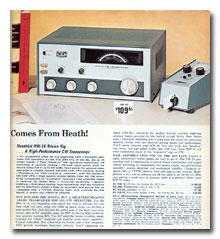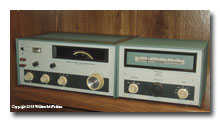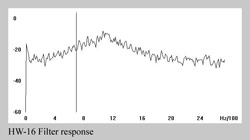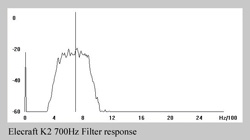
by William Eric McFadden
From the HW-16 manual:
-
The Heathkit Model HW-16 CW Transceiver is a high performance and economical amateur radio receiver and transmitter. Although it is designed with the Novice Class operator in mind, this Transceiver is also an excellent piece of equipment for the General Class operator. The Transceiver provides full break-in CW communications in the lower 250 kHz segments of the 80-, 40-, and 15-meter bands.The transmitter is crystal-controlled, using 80-meter crystals on 80- or 40-meter bands, and 40-meter crystals on 40- or 15-meter bands. The Transceiver also has provisions for an external VFO.Input power to the final stage is adjustable for 50 to 90 watts input. A 75 watt marker on the meter, which indicates plate current, represents maximum power for Novice Class operation. All three stages of the transmitter are grid-block keyed. The only tuning required when changing bands or frequency is adjusting the final Tune capacitor.The receiver uses dual conversion for excellent image rejection and the receiver's front end is crystal controlled for excellent stability. For high selectivity, the receiver uses a 500 Hz crystal filter. The receiver is automatically muted each time the key is depressed, providing full break-in operation. No external antenna relay is required, as antenna switching is accomplished within the Transceiver.
HW-16 Specifications: Transmitter RF Power Input 50 to 90 watts (adjustable) Frequency Control 80-meter crystal or VFO on 80-meter band.
80- or 40-meter crystal, or VFO on 40-meter band.
40-meter crystal or VFO on 15-meter band.Keying Grid-block, break-in, with automatic antenna switching and receiver muting. Output Impedence 50 ohm unbalanced, SWR not to exceed 2:1. Side Tone neon relaxation oscillator. Receiver Sensitivity Less than 1 microvolt for 10 dB signal-plus-noise to noise ratio. Selectivity 500 Hz at 60dB down. Image Rejection 70 dB or better. IF Rejection 35 dB or better. Intermediate Frequency 3396 kHz. Antenna Impedence 50 ohm unbalanced. External Speaker Impedence 8 ohm. General Frequency Coverage 3.5 to 3.75 MHz.
7.0 to 7.25 MHz.
21.0 to 21.25 MHz.Power 120 VAC 50/60 Hz. Transmitter Tube Complement 6CL6 Crystal Oscillator.
6CL6 Driver.
6GE5 Final.Receiver Tube Complement 6EW6 RF Amplifier.
6EA8 Heterodyne mixer-oscillator.
6EA8 VFO mixer-oscillator.
6EW6 IF amplifier.
12AX7 Product detector-oscillator.
6HF8 1st audio and audio output.Transistor Complement 2N1274 muting circuit. Dimensions 13-3/4" wide x 11-1/2" deep x 6-1/2" high. Net Weight 20 lbs.
Description of HG-10 from Heathkit catalog:
-
The new Heathkit HG-10 VFO covers from 80 through 2 meters with each band separately calibrated on a rotating drum-type slide-rule dial. The circuit uses the popular series-tuned Clapp oscillator with a cathode-follower output for isloation and regulated plate voltage for maximum stability. Its vernier tuning has a 20 to 1 gear drive... and there's a "spot" switch for off-the-air-tuning.The circuit is designed for grid-block keying with the new Heathkit DX-60 or for cathode keying with other transmitters. Everything is mounted on a rigid steel chassis for superior mechanical strength and freedom from chassis instability... and it's all wrapped up in a handsome cabinet to match the DX-60. Power is obtained from the transmitter... just plug it into the DX-60, or make simple changes to use with other transmitters. All cables are supplied.
HG-10 Specifications: Band Coverage: 80, 40, 20, 15, 10, 6 and 2 meters. Load Impedence: 50K ohms or more. Output voltage: 5 volts R.M.S. or more, with no load. Output connections: phono plug. Front panel controls: Function Switch (Stby/Opr/Spot), VFO tuning & Band selector. Tube complement: 6CH8-oscillator-cathode follower; OB2-voltage regulator. Power requirements: 1. from Accessory socket of DX-60, using cable furnished,
2. from accessory socket of DX-40, with simple changes,
3. From other sources: 140 volts min. @ 25 ma; 6.3 volts ac or dc at 0.75 amp.Cabinet size: 9-3/8" wide, 9" deep, 6-1/2" high.
The HW-16 was offered from 1967 through 1976 (source) and was designed for Novice licensees who, at the time of the HW-16's design and introduction, were limited to 75 watts input and crystal-controlled transmit, CW only, on 80, 40, and 15 meters. Essentially a separate transmitter and receiver in one cabinet, the HW-16 is a vacuum tube, CW-only transceiver covering the bottom 250 kHz of 80, 40, and 15m with variable receive tuning and crystal-controlled transmit at up to 90 watts input. The HW-16 featured a 500Hz crystal filter, single-control transmitter tune-up, and full break-in (QSK) operation.
(The requirement for crystal-controlled transmit for Novice licensees was dropped in 1972 and, at the same time, Novices lost their 2m privileges but gained CW privileges on 10m. One might ask, why didn't Heathkit add 10m coverage to the HW-16 after 1972? And, were most of the HW-16 kits purchased after 1972 purchased along with an HG-10B VFO?)
I earned my Novice license some six years after the FCC allowed Novices to use VFO-controlled transmitters but for as long as I can remember I have wanted an HW-16 for my station. I finally purchased an HW-16 and HG-10B VFO in February, 2008, at the Mansfield Mid*Winter Hamfest. Both the transceiver and the VFO were cosmetically clean but the HW-16 lacked a sidetone on transmit and received signals were unstable (warbly) and somewhat raspy, and the HG-10B lacked a power-cable.
 In renovating this HW-16, I installed a set of replacement electrolytic capacitors (from Hayseed Hamfest),
replaced the sidetone-circuit neon lamp, and performed a realignment. The receiver warble remained, however.
I thought I had traced this to a mechanically-unstable trimmer capacitor on the main tuning capacitor and
was able to shim this trimmer-cap with fiber washers but even with the trimmer tightened all way down the
receiver warble is still very evident on strong signals. Liberal application of De-Oxit and reflowing solder
joints on the circuit-board haven't solved the problem so more work is required before this rig will be
enjoyable to use as a transceiver. (Here are notes from WB4LNM, "One of the Hams
from Heath", regarding this instability problem.)
In renovating this HW-16, I installed a set of replacement electrolytic capacitors (from Hayseed Hamfest),
replaced the sidetone-circuit neon lamp, and performed a realignment. The receiver warble remained, however.
I thought I had traced this to a mechanically-unstable trimmer capacitor on the main tuning capacitor and
was able to shim this trimmer-cap with fiber washers but even with the trimmer tightened all way down the
receiver warble is still very evident on strong signals. Liberal application of De-Oxit and reflowing solder
joints on the circuit-board haven't solved the problem so more work is required before this rig will be
enjoyable to use as a transceiver. (Here are notes from WB4LNM, "One of the Hams
from Heath", regarding this instability problem.)
In building the required power and rf-signal cables to connect the HG-10B to this HW-16, I found that the VFO had been modified by a previous owner for use with a DX-40 transmitter. Fortunately, the mods were simple to undo and are well documented in the HG-10B manual. With the required cables built, the VFO worked beautifully and didn't even require alignment.
I have received glowing reports on the quality of my HW-16's transmitted signal.
While I try to resolve my HW-16's receiver stability problem, I've been enjoying using the HW-16 as a transmitter, listening on my Drake 2-C / 2-CQ receiver, and using an MF-1708 "RF Sensing T/R Switch" to handle the transmit/receive switching duties. (I've also used my Elecraft K2 and my Heathkit HW-8 as receiver with the HW-16.)
I acquired a second HW-16 at the Findlay Hamfest in September, 2009. This rig is costmetically ugly, lacking a dial, dial-glazing, bezel, and cabinet-top, but seller assured me that the rig operated well. The asking price was such that I could justify the purchase based on the value of the tubes alone. This rig is now serving as a parts-donor rig for my operable HW-16.
UPDATE: After noticing that my HW-16's CW filter response seemed to much too wide, I used Spectrogram to look at the filter response and the results pretty clearly indicate that my HW-16 effectively has no functional CW filter. This might help explain the warbly receive audio my HW-16 has. Presented below are two Spectrogram plots. The first is of the HW-16. The second is of my Elecraft K2 with the 700Hz CW filter engaged.
Hoping to improve the performance of this HW-16's CW filter, I swapped the bandpass-transformer from my parts-rig HW-16 (see below) into the operational HW-16. Unfortunately, this swap did not improve the performance of the CW filter nor did it fix the warbly receive audio problem.
UPDATE 2019-02-22: I acquired a third HW-16 at the Mansfield Mid*Winter Hamfest in February, 2019 for a too-good-to-pass-up price of $45. This transceiver is very clean externally and was purchased with the understanding that the transceiver is inoperative on 15m due to a broken slug in the 15m calibration inductor. I've tested the transceiver and it has good sensitivity on 80m and 40m, and it generates a very stable and clean transmit signal on 80m via crystal-control and when being driven by my HG-10B VFO. The power/current meter and the sidetone oscillator are both inoperative. The receiver has a bit of AC hum, probably indicating a need for new electrolytic caps.
I purchased this HW-16 in the hope that this HW-16 would not exhibit the warbly receive that my first HW-16 does. Unfortunately, this HW-16 does have the same warbly receive audio. However, in testing this transceiver, I discovered that the receive audio appears to warble only when the HW-16 is connected to my 135' ladderline-fed doublet and not when it is connected to my coax-fed ground-mounted vertical antenna. After I made this discovery, I tested my first HW-16 again and have confirmed that it, too, appears to warble only when used with the doublet, leading me to wonder if the true culprit is slight impedence changes in the antenna system as the ladderline shifts in the wind — or, rather, if the culprit is a receiver design that doesn't properly isolate the HW-16 receiver from changing antenna impedance.
By ear, CW filter characteristics of the third HW-16 seem to be just as poor as those of my first HW-16, leading me to suspect that the CW filter in the HW-16 is simply a mediocre design.
Because my original HW-16 has been re-capped, has a working meter, and doesn't hum, I've returned this transceiver to its original position on the radio desk and to again use it as a transceiver, primarily with the coax-fed vertical antenna, with which the HW-16 shows no evidence of warble. To help with the HW-16's poor CW filtering, I'll use this HW-16 with an Autek QF-1A audio filter.
Since it's so clean externally, I may still attempt to restore the third HW-16's 15m performance using parts from my parts-donor rig, fix the meter, fix the sidetone, clean the dirty controls, and possibly even re-cap the thing if I can do so without spending lots of money.
UPDATE 2019-02-24: On an afternoon with seriously gusty winds, I discovered that neither of my operational HW-16s exhibits significant warble on 40m when hooked up to either the ladderline-fed doublet or the vertical, so the problem of warbly-receive exists only on 80m. At least on 40m, my hypothesis about wind-caused impedence changes causing the warbly-receive doesn't hold up. I did notice that the doublet doesn't "hear" significantly louder than the vertical on 40m as it does on 80m, so perhaps the doublet's stronger signals on 80m has some bearing on the problem.
UPDATE 2020-02-17: Needing money for the upcoming Dayton Hamvention, I sold my third HW-16 at the Mansfield Mid*Winter Hamfest for $5 more than I paid for it it at the same event in 2019 and in the same condition it was in when I purchased it.
Advertisements:
HW-16 Links
- Heathkit HW-16/HG-10 Group at Yahoo! Groups
- N0JMY's Hayseed Hamfest offers replacement capacitor sets and front-panel overlay for HW-16
- HW-16 Parts at OldHeathkitParts.com
- The following articles are available to ARRL members; search the QST Archives:
- Recent Equipment: Heathkit HW-16 C.W. Transceiver,
by George Grammer, W1DF (January, 1968 QST) - Sunspots and the HW-16,
by Earl Savage, K4SDS (May, 1978 QST) - Adapting VFOs for the HW-16,
by Wm. B. Vokac, K9WQY (November, 1974 QST) - Modifying the Heath HW-16 from 15 to 20 Meters,
by Llewellyn Rose, G5BGA (November, 1975 QST) - Hints and Kinks: Help for the HW-16,
by Stan Grimes, W7CQB (August, 1979 QST) - Hints and Kinks: Sidetone Level Adjust for the Heath HW-16,
by Jose Armengol, WA2BNM (May, 1977 QST) - Hints and Kinks: Putting the HW-16 on 20 Meters,
by Bud Haake, W0MSV (August, 1972 QST) - HW-16 Mods here & here, compiled by WA3REY
- HW-16 Mods, by K5DH
- HW-16 Mods, by W7EKB
- HW-16 Sensitivity Fix, by Chuck Adams, K5FO
- HW-16 mods including QRP output, sensitivity, and sidetone, by Joe Galicic, N3HEE
HG-10 Links
- 1st Heathkit HW-16/HG-10 Group at Yahoo! Groups
- 2nd Heathkit HW-16 Group at Yahoo! Groups
- The following articles are available to ARRL members; search the QST Archives:
- Recent Equipment: Heathkit Model HG-10 VFO,
by Edward Tilton, W1HDQ (October, 1963 QST) - Hints and Kinks: More Output from HG-10 Series VFO,
by Jon Harder, W1GVN (July, 1976 QST)
Attributions:
- 1961 catalog page found at Technology Systems.
- 1963 catalog page found at Technology Systems.
- 1969 catalog page found at HW16-Heathkit-HW-16 at Yahoo! Groups.


